Classic 3-Oil Soap: Olive, Coconut, and Palm
© 2010 by KV5R — Rev. Dec. 1, 2010.
Shop for soap making supplies here.
Goals
- Acquire better soap-making skills.
- Make a small batch of 3-oil soap.
- Make exactly the right amount to fill a 6-cavity mold.
Why?
- The first batch, 100% olive oil, didn’t make good suds, and was too soft. Learned that olive needs about 20-30% coconut for cleansing and 20-30% palm for creamy suds.
- I want to make some soap good enough to give to friends.
- I want to try a silicone mold.
Tools and Supplies Used
Same as the first batch, with the addition of coconut and palm oil, and a silicone mold that makes six 3x3x1¼-inch square 6-ounce bars.
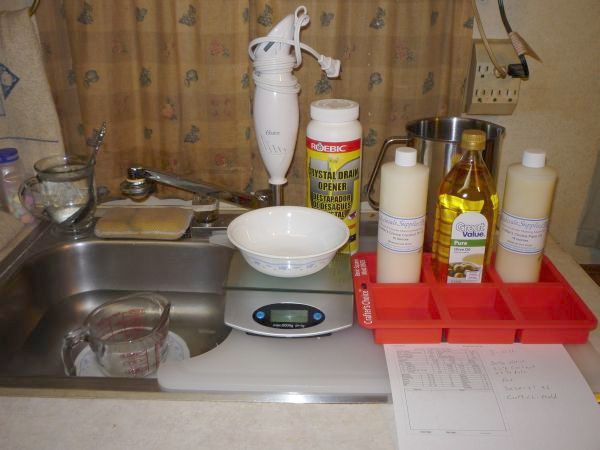
Tools and Supples Used
Recipe
Classic 3-Oil Soap; recipe developed on soapcalc.net (by me) after reading several articles on 3-oil soaps. This time, I used grams instead of ounces to get better resolution from the little scale. My new mold has a total volume of 6x9x1¼ inches, so I then used the summerbeemeadow.com calculator, which allows one to re-size the batch to fit a certain rectangular mold volume (won’t work with odd-shaped cavities; see below).
- 50%, 402g. Olive Oil (Walmart)
- 25%, 201g. Coconut Oil 76° (wholesalesuppliesplus.com)
- 25%, 201g. Palm Oil (wholesalesuppliesplus.com)
- 115g. NaOH × 2.333 = 268g. water = 30% caustic solution
- 5% Superfat (SF)
- Unscented.
Procedure
Now that I’ve written the articles on the previous 6 pages, I’ll test my assumptions by following my own procedures (more or less).
- Weigh water into Pyrex cup. Chill water down to 60°F.
- Weigh lye and mix with the cold water (with cup in sink water and ventilation running).
- Weigh each oil into SS pitcher and put on stove to heat.
- Stabilize both temperatures at 115°F.
- Stick-blend until full trace.
- Pour into cavity mold. Crafters Choice™ Silicone Mold #0605 (wholesalesuppliesplus.com). Makes (6) ~6 oz squares.
- Cover and insulate overnight.
- Clean-up.
- Cure 4 weeks.
- Make fancy old-fashioned wrappers on the computer and print on fancy cotton-bond stationery paper.
Total time: about 1 hour, including pictures and clean-up.
Conclusion: The process went well; trace was again much faster than expected; and my volumetric calculations were almost correct: I had 1-2 fl. oz. too much for the cavity mold.
Perhaps a better way to calculate soap volume: The specific gravities of vegetable oils is about .88 to .93, so to simplify let’s call it .90. We can estimate the soap’s final volume by taking the oil weight, 28.36 ÷ .9 = 31.51, + the water weight, 9.46 ~= 40.9 fl oz. My cavity mold will hold 38 fl oz, so I want to make 39 fl oz of soap (~1 oz left over clinging to pot and utensils). If we decide that 9 oz of water is close enough, we can subtract that, and need 30 fl oz of oils, and since we say the oils’ S.G. is .9, 30 × .9 = 27 ounces (weight) of oils. I used about 28.5, and indeed had about 1½ oz too much, so maybe the .9 S.G. is a good figure. I’ll do it that way next time and we’ll see.
Tomorrow: Getting bars out of the silicone mold was harder than expected. The problem is stretching the mold enough to get air under the soap without damaging it. Hot water on the bottom helped. Also, the soap was too thick when I poured, and it held some bubbles around the sides of the mold.
So how does it work? Tried a bar after 12 days curing and it’s very nice, much like Ivory, as expected. Good hardness, good suds, and good cleaning. Rinses easily with no oily film. No wonder that recipe is called classic 3-oil.
Pictures
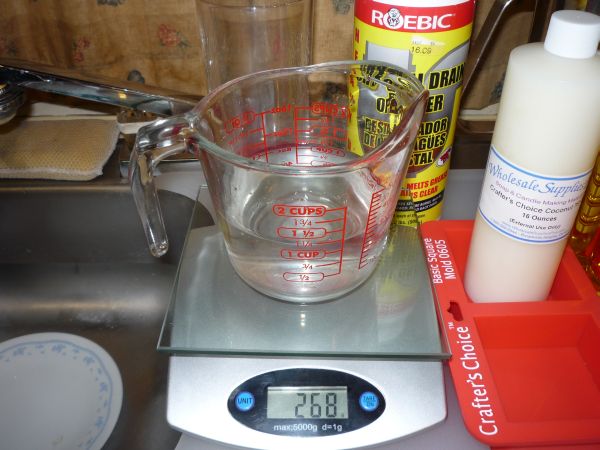
268 grams of water…
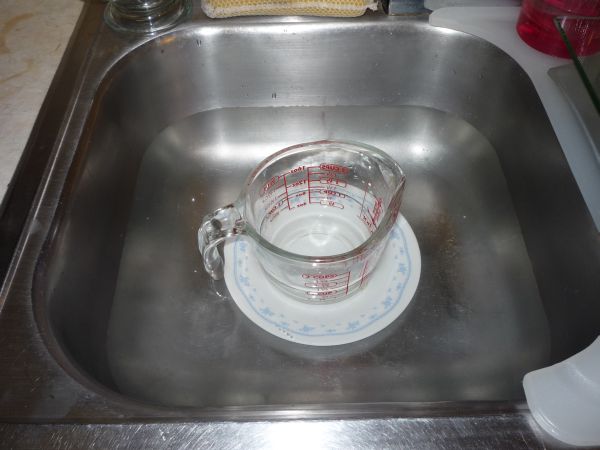
Water cup in sink water…
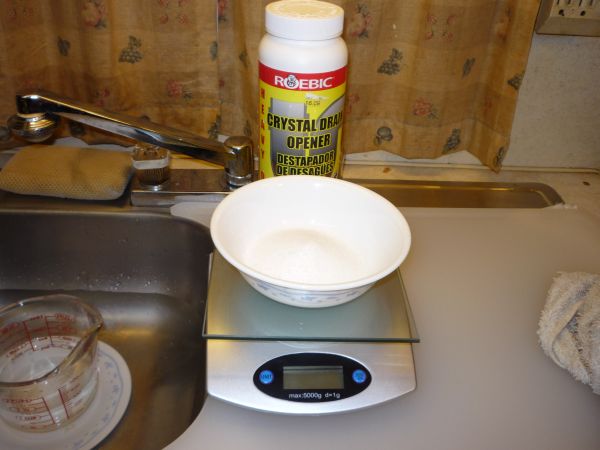
115 grams of lye…
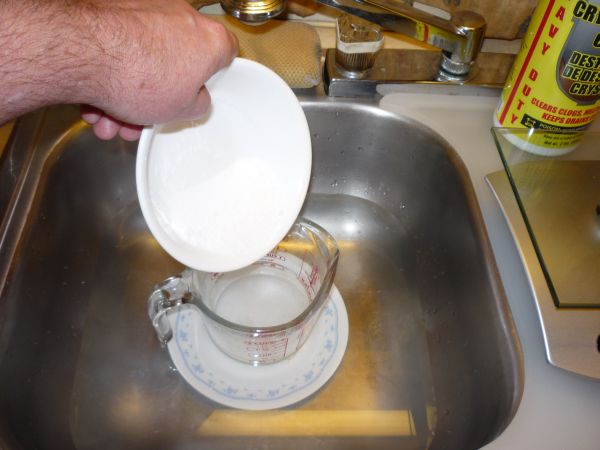
Dump the lye into the water…
(You really should use rubber gloves here.)
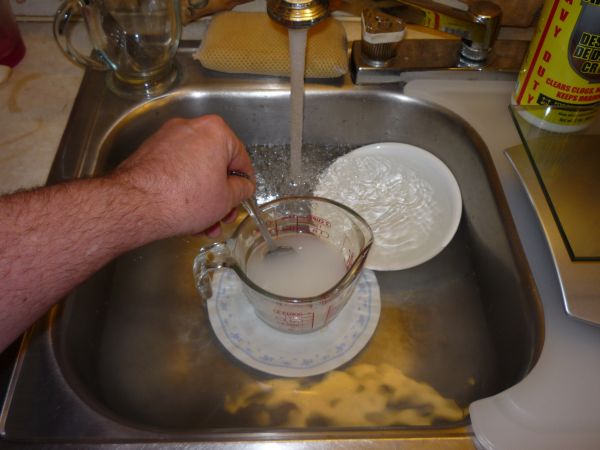
Stir it for 2-3 minutes — the water was pretty cold, so it didn’t make fumes.
The lye wants to clump in the bottom, so you have to dig around in the corners a little.
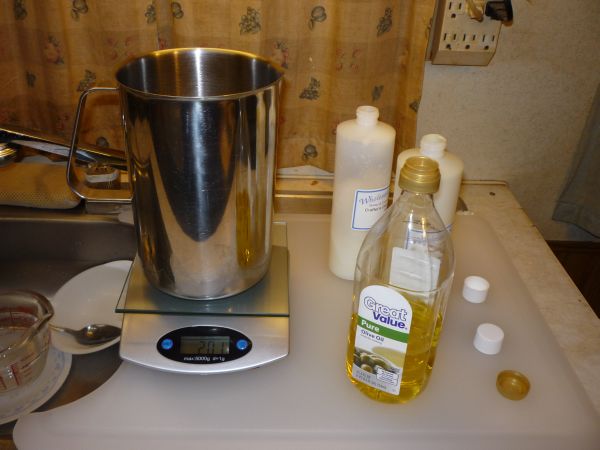
Tare the pot, pour in 402g of olive oil,
Tare the pot, pour in 201g of coconut oil,
Tare the pot, pour in 201g of palm oil.
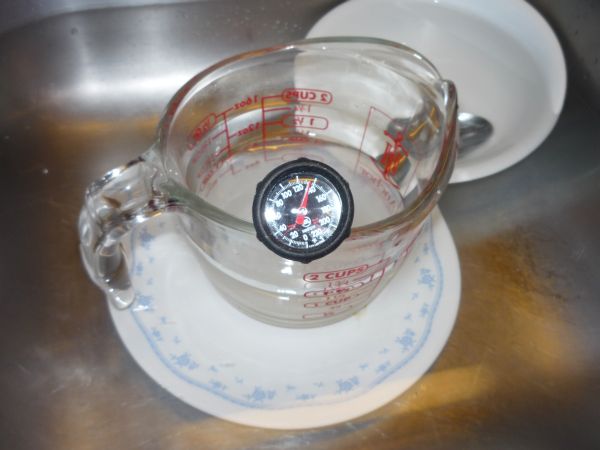
The caustic hit 160 but is already down to 135°F.
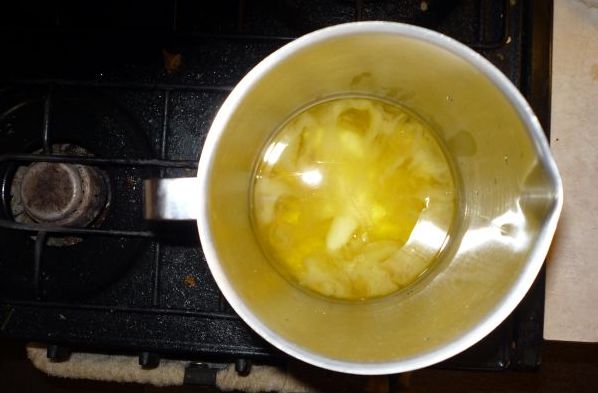
The oils needs some heat.
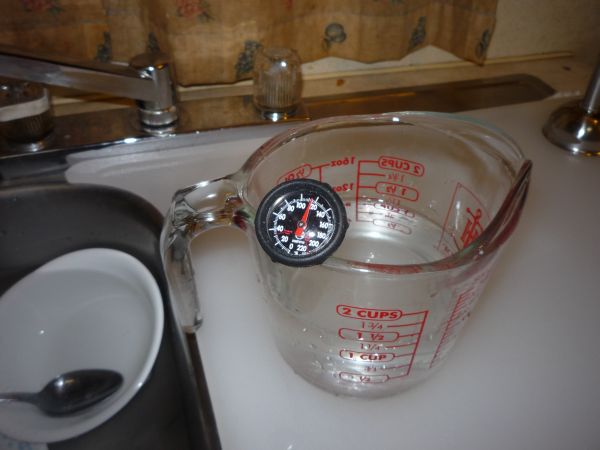
The caustic is already down below 120, so I took it out of the cooling water.
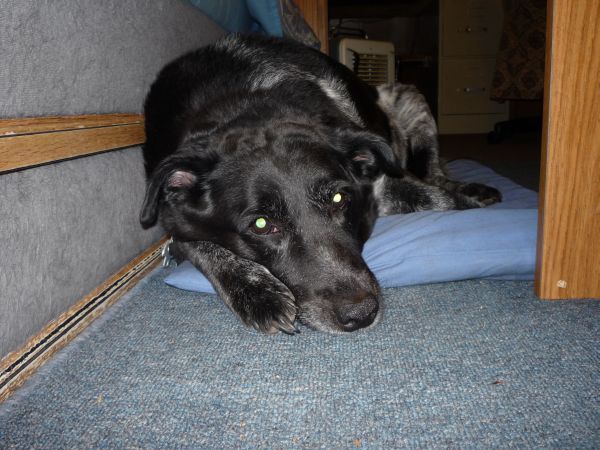
Waggin’ thinks I’m cooking, and he’s not getting any…

OOPS! I let the oils get to 135, and that was a very low fire!
See what happens when you don’t pay attention?
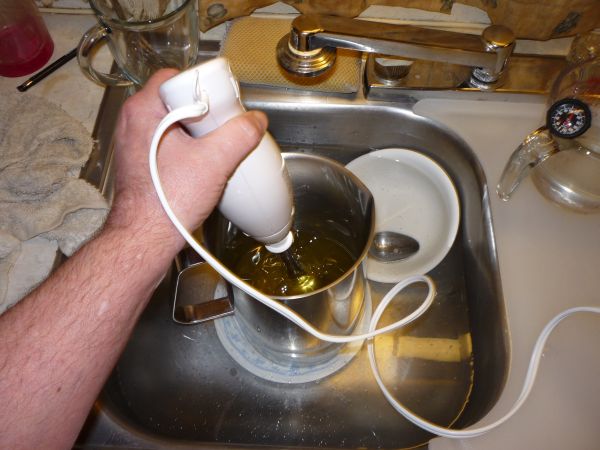
So I put the oil pot in the sink water and spun it for a bit,
then left it in that safer place for pouring in the caustic.
I can’t show pouring the caustic into the oil because that wasn’t a good time to handle the camera.
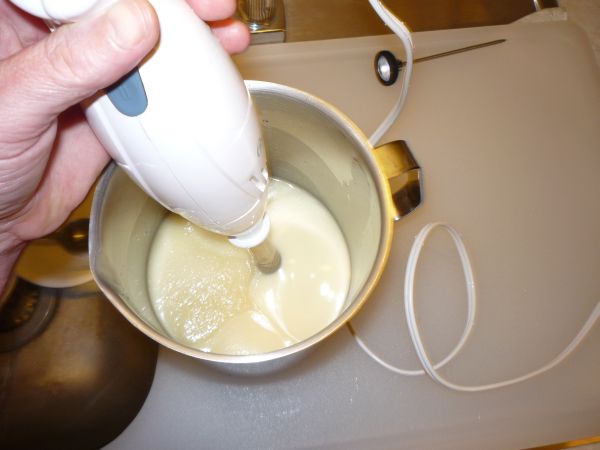
It whizzed to light trace in about a minute! Full trace less than a minute later.
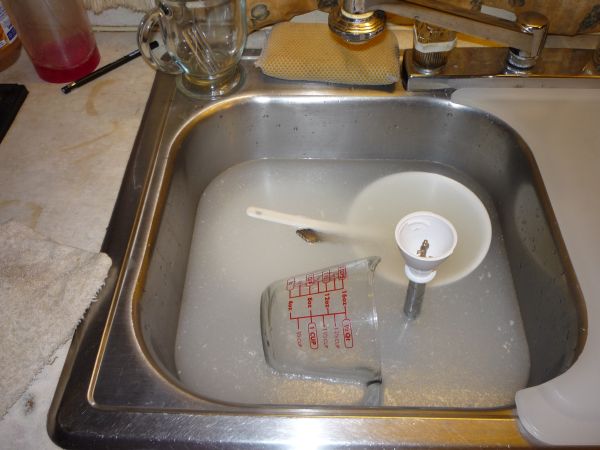
That was a dumb move! Instead of putting water in the empty pot and whizzing it,
I just whizzed the blender in the sink water. Now everything that had caustic on
it also has oil on it, requiring a lot more clean-up. I won’t do that again!
Here’s the second time both hands were busy and I couldn’t use the camera.
I used the rubber cake spatula to rake the soap “pudding” into the mold’s six cavities,
then spent several minutes patting it into the corners with the cake spatula.

Then covered the mold with cling wrap and smoothed out the surface…
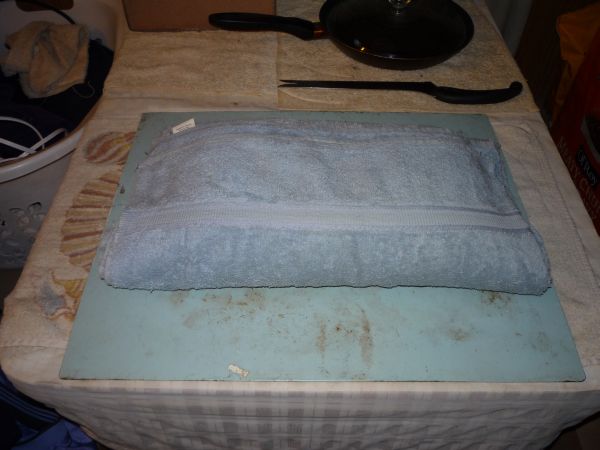
That’s a big towel, folded twice, then the ends folded over the top.
There are 4 layers under, and 8 layers over the mold. It did a full gel phase.
One note here about the mold: Silicone molds are very flexible, and quite difficult to pick up when full of fresh soap. What I need to do is cut two little pieces of thin plywood (or paneling) the same size as the mold: One on top of the cling wrap to just mash the surface smooth, and another underneath so the mold can be picked up level for moving and wrapping. No, here’s a better idea: two pieces of ¾-inch polyiso sheathing! One on top, one on bottom, and it’s an R-5 insulated soap-mold sandwich. Next time…
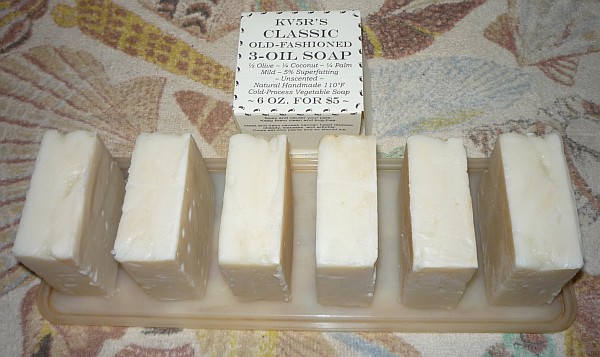
Next day: there it is! And there’s my prototype wrapper.
It looked a lot better after rubbing it smooth with wet hands.
So there you have it, my second batch. What did I learn?
- You can nearly calculate the volume of soap needed for a cavity mold, even though working with materials by weight.
- Using grams instead of tenth-ounces is 3 times more accurate (~30g per oz).
- COLD water for lye means no fumes.
- A mere 28 oz of oil will heat up very quickly even on a low fire.
- Cavity molds need a stiff sheet of something, top and bottom. Polyiso sheathing should work nicely.
- The soap set too fast and was not easy to pour. As a result, the mold held some bubbles and didn’t make pretty edges. Next time I’ll try to pour a little sooner.
- I also noticed (online) that the soaping properties of soybean oil are almost the same as olive oil—at one-fourth the cost. Crisco “Pure Vegetable Oil” is 100% soybean oil; got 48oz today for $2.50.
My next batch might be is 3-oil with Pine Tar and Citronella — a ‘woodsman’ and camping soap for us deep-woods types. Might add an abrasive, too. Will also probably make a mild dog soap with some citronella in it. And am eager to make some laundry soap!
So until the next batch, good soaping! —KV5R

Dear Soapmakers,
Regarding the Lye/Soap Calculator, we would like to invite you to try our Soap Calculator on our web-site.
the 1° Soap Calculator able to calculate also the % of Glycerin inside your soap !
We published our updated new Soap Calculator here: http://www.soapworld.biz/soap-calculator-handmade-soap.html
Good Soap !